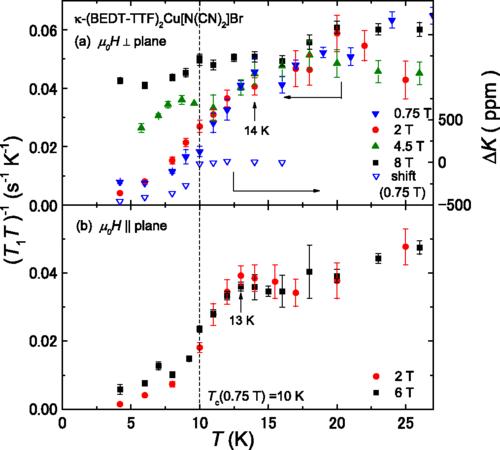Topics
- Superconducting fluctuations in κ-(BEDT-TTF)2Cu[N(CN)2]Br
- Commensurability of SDW in (TMTSF)2PF6
- Charge ordered state in β''-(BEDT-TTF)3Cl2⋅2H2O
- Correlation between non-Fermi-liquid behavior and anti-ferromagnetic fluctuation in (TMTSF)2PF6
- Low-frequency dynamics of κ-(BEDT-TTF)2Cu(NCS)2
- Zero-gap-semiconductor state of α-(BEDT-TTF)2I3
Superconducting (SC) fluctuation is that a short-range SC state occurs in the normal state above a SC transition temperature Tc and is thought to be enhanced by strong electron correlations. The SC fluctuation of high-Tc cuprate has been extensively investigated, but the observation of pure SC fluctuation is difficult because of pseudogap state above Tc. An organic superconductor κ-(BEDT-TTF)2Cu[N(CN)2]Br is an appropriate compound for the study of SC fluctuation since Fermi liquid state is established above Tc. Therefore, we focused on this material and examined the SC state using 13C NMR spectroscopy.

Figure shows that the results of spin-lattice relaxation time T1 measurements in several magnetic fields. In 8 T, 1/T1T shows temperature independent behavior below 20 K, that is, SC state is destroyed and Fermi liquid state emerges. Contrastingly, we observed the decrease in 1/T1T below 14 K in the magnetic field applied parallel to the conduction plane and below 13 K in the weak perpendicular field. These temperatures are higher than Tc = 10 K (dashed line), which is determined by the abrupt decrease in the NMR shift. Because 1/T1T below 14 K is increased by applying high magnetic fields, we concluded that the decrease in 1/T1T at the temperature higher than Tc is due to the SC fluctuation. These results are the first clear observation of the decrease in the quasiparticle density of states by SC fluctuation.
The paper titled gMicroscopic observation of superconducting fluctuations in κ-(BEDT-TTF)2Cu[N(CN)2]Br by 13C NMR spectroscopyh has been published in Phys. Rev. B 89, 165141 (2014).